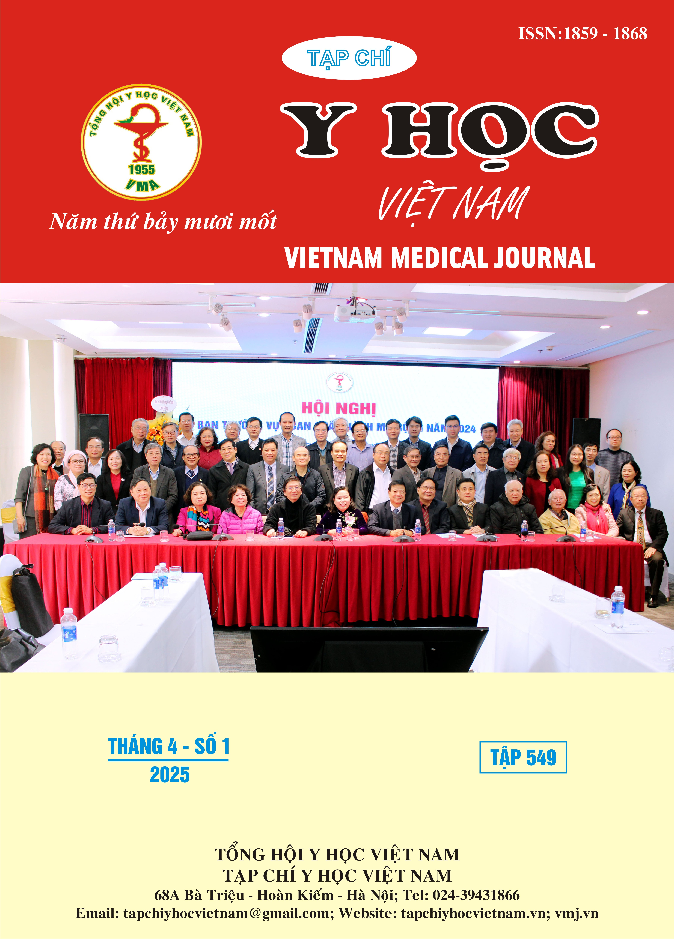CORRELATION OF SOME CLINICAL FEATURES WITH HISTOPATHOLOGICAL CLASSIFICATION OF HYDATIDIFORM MOLE
Main Article Content
Abstract
Background: Molar pregnancy is an abnormal pregnancy, most common in Southeast Asia with an incidence of 2-13/1000 pregnancies. Molar pregnancy can progress to trophoblastic neoplasia, which carries a high mortality rate. Currently, there are no studies in Vietnam that combine and compare the clinical characteristics and histopathological classification of molar pregnancies to better understand the diagnostic role of risk factors, ultrasound, and β-hCG levels in the diagnosis of molar pregnancy. Objective: To compare clinical characteristics with histopathological classification of molar pregnancy. Methods: A retrospective, cross-sectional descriptive study was conducted, including 88 molar pregnancy cases at Hung Vuong Hospital from July 2022 to March 2024. The research process involved evaluating clinical characteristics and histopathological classification of molar pregnancy. Data were analyzed using STATA 14.0 software. Results: The study on 88 cases of molar pregnancy revealed an average maternal age of 32.3 years (standard deviation 8.8 years). The average gestational age at diagnosis was 8.5 weeks (standard deviation 2.5 weeks). Of the patients, 29.6% had a history of spontaneous miscarriage, and 3.4% had a history of molar pregnancy. The average pre-curettage β-hCG level was 143,032 mIU/mL. The average time for β-hCG to return to negative was 8 weeks. Ultrasound before curettage identified 64.8% of cases. Histopathological classification showed 15 cases of early-stage complete molar pregnancy (17%), 54 cases of complete molar pregnancy (61.4%), and 19 cases of partial molar pregnancy (21.6%). Conclusion: The study provides an overview of clinical factors related to molar pregnancy, including maternal age, gestational age, obstetric history, β-hCG levels, time for β-hCG to return to negative, and ultrasound findings.
Article Details
Keywords
Molar pregnancy, β-hCG
References
2. Sun SY, Melamed A, Joseph NT, et al. Clinical presentation of complete hydatidiform mole and partial hydatidiform mole at a regional trophoblastic disease center in the United States over the past 2 decades. International Journal of Gynecologic Cancer. 2016;26(2)
3. Joneborg U, Folkvaljon Y, Papadogiannakis N, Lambe M, Marions L. Temporal trends in incidence and outcome of hydatidiform mole: a retrospective cohort study. Acta Oncologica. 2018;57(8):1094-1099.
4. John R, Lurain M. Gestational trophoblastic disease I: epidemiology, pathology, clinical presentation and diagnosis of gestational trophoblastic disease, and management of hydatidiform mole. Am J Obstet Gynecol. 2010;9
5. Gockley AA, Melamed A, Joseph NT, et al. The effect of adolescence and advanced maternal age on the incidence of complete and partial molar pregnancy. Gynecologic oncology. 2016;140(3):470-473.
6. Joneborg U, Marions L. Current clinical features of complete and partial hydatidiform mole in Sweden. J Reprod Med. 2014;59(1-2):51-5.
7. Fowler D, Lindsay I, Seckl M, Sebire N. Routine pre‐evacuation ultrasound diagnosis of hydatidiform mole: experience of more than 1000 cases from a regional referral center. Ultrasound in obstetrics & gynecology. 2006;27(1):56-60.


